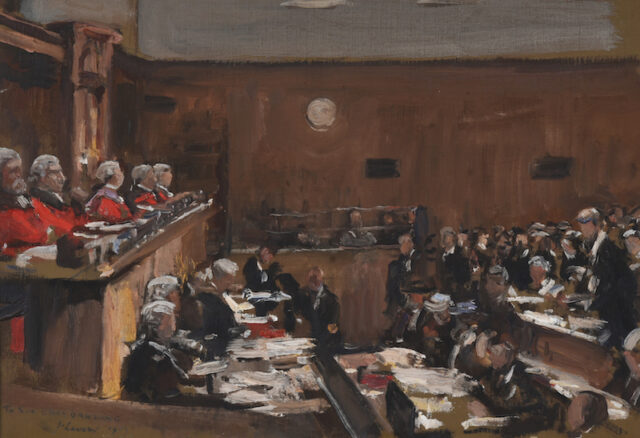Lavery’s ‘Grey day’ Strait of Gibraltar landscape to go under the hammer
Images via Dreweatts/PA
A painting of the Strait of Gibraltar by celebrated Belfast painter Sir John Lavery will go under the hammer this week.
The painting, one of several images to be auctioned, is believed to be a view from Lavery’s house near the medina in Tangier.
Other images that will be auctioned include an original courtroom sketch that has never been seen in public before.
Lavery produced the oil sketch inside the Court of Criminal Appeal in London in 1916 during an appeal by Sir Roger Casement, who had been convicted of treason for his efforts in trying to gain German military aid for the 1916 Easter Rising in Dublin.
It was used as a preparatory study for Lavery’s famous later painting The Hearing of the Appeal of Sir Roger Casement.
The artist created the study with Casement, who was hanged in 1916, looking straight out towards the jury box.

Art historian Kenneth McConkey said: “For those two days Lavery, accompanied by his wife Hazel, sat in the witness box recording the scene in the present sketch.”
“During the painful excursion into a legal precedent deriving from a 14th century statute on treason, Lavery’s concentration on the scene before him was intense.”
“Although he made efforts to conceal his industry, the production of the present 10in x 14in canvas board in an awkward space was detected by the press, as well as by the prisoner in the dock facing him.”
Also on sale will be two portraits from the family of the presiding judge in the appeal, Sir Charles Darling, and an oil sketch for his celebrated portrait of Mrs Roger Plowden and Humphrey from 1897.
Jennie Fisher, co-head of Dreweatts Modern and Contemporary Art, said: “We are thrilled to be able to offer a cross-section of works demonstrating the breadth and range of Lavery’s work, from an evocative example of his plein air landscape painting, to society portraits, through to a rare and important study for one of his most important historical commissions.”
“The preparatory study of The Hearing of the Appeal of Sir Roger Casement is undoubtedly the highlight of the group and significant not only for its superb draughtsmanship, but for its portrayal of a hugely important moment in Anglo-Irish history.”
The paintings will be auctioned in Dreweatts Modern and Contemporary Art sale at their Donnington Priory saleroom in Newbury, Berkshire, on March 13.
Lavery was born in a small spirit-grocer’s shop in North Queen Street, Belfast, in 1856 and was orphaned at the age of three.
After training as an artist in France, he found fame after he was commissioned to paint the state visit of Queen Victoria to the International Exhibition in Paris, and later painted George V and his family.
He taught Winston Churchill to paint.
The artist is the subject of a major touring exhibition – Lavery on Location – organised by the National Gallery of Ireland, currently in the Ulster Museum in Belfast and ending at the National Gallery of Scotland’s Edinburgh Festival Exhibition.
In exploring the background of the Strait of Gibraltar painting, Dreweatts cited a 1911 book by Walter Shaw Sparrow, ‘John Lavery and his Work’, ahead of the auction.
“Although we cannot be certain where A Grey Day was painted, given that it passed through the Goupil Gallery in 1908, it seems very likely that the present work represents the Straits of Gibraltar viewed from a hillside to the west of the Medina at Tangier,” the book reads.
“ Having recently purchased a house and garden on the hilltop in question - Mount Washington - Lavery had the opportunity to study the moods of the sea from several discreet vantage points.”
“This accounts for the variety of effects that characterise the many seascapes that followed - the high and low horizons, for instance, that appear in this and other small seascape sketches, such as A Rough Sea (Paisley, Art Institute Collection, held by Paisley Museum and Art Galleries), also shown in the Goupil exhibition.”
“While many of these small sketches were painted in full winter sunshine, there were occasions when grey overhanging clouds must have reminded the artist of his earliest paintings of the Irish Sea seen from the Antrim coast in the late 1880s.”
“Vivid colour arrived with his first visits to the North African coast in the 1890s, but it was a decade later when he returned to a more sustained engagement with the great maritime trade route that other, larger 'grey days' appeared (for example, see A Grey Day, Tangier, 1911 held by the Art Institute of Chicago from the George F. Porter Collection).”
“While artists' enchantment with the sea stretches back to the romantic generation and beyond, the importance of the little sketches of 1906-8, lies in the fact that they provide instances in which Lavery reassesses one of Whistler's favourite themes and works through the more recent advances he had noted in Monet's work.”
“In the first exhibitions of the International Society of Sculptors, Painters and Gravers, as the society's vice-president and prime mover, he had the opportunity to view the work of these mentors at close quarters, and move on.”
“Up until the outbreak of war, every winter with only one exception, was spent on the Moroccan heights and seascapes with passing ships became a leitmotif. With its heavy sky, breaking waves and wrack-strewn sands, A Grey Day hailed this renewed fascination.”









